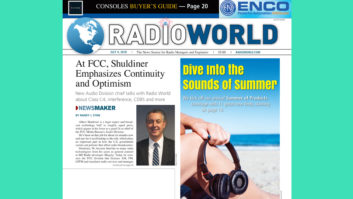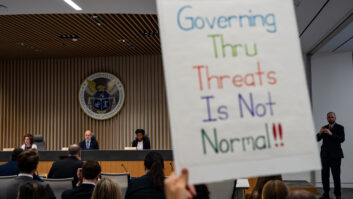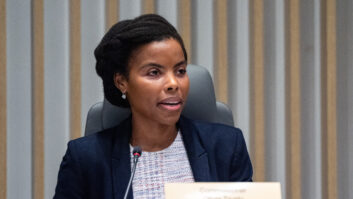Albert Shuldiner is a legal expert and broadcast technology buff in roughly equal parts, which argues in his favor as a good fit as chief of the FCC Media Bureau’s Audio Division.
He’s been on that job for about six months now and says he is acclimating to the role, which plays an important part in how the U.S. government carries out policies that affect radio broadcasters.

Shuldiner, 56, became familiar to many radio technologists from his years as general counsel at HD Radio developer iBiquity. Today he oversees the FCC division that licenses AM, FM, LPFM and translator radio services and manages instances of interference, a topic that has occupied much of his time since he joined in January 2018.
The University of Pennsylvania Law School grad succeeded Peter Doyle as audio division chief. In late May, he discussed a variety of front-burner issues with Radio World, including the possibility of broadcasters sharing the C-band and the creation of a Class C4 FM service. He also discussed working at the FCC under the leadership of Chairman Ajit Pai and the outlook for the media modernization initiative.
Radio World: What have the first few months been like and what has surprised you about the job?
Albert Shuldiner: It’s been busy. We have a very high volume of cases that we process in this division. I have really focused on getting up to speed on pending matters. And being new to the commission, it has taken time to get to know people here in the front office and within the Media Bureau. That’s been a big part of my focus. Michelle Carey, chief of the Media Bureau, has been very welcoming.
I have also spent time speaking with people from within the industry and taken meetings with those in radio trying to understand their top concerns. That outreach is important to me.
RW: What are some of those matters taking up a lot of your time?
Shuldiner: It’s those things everyone has been reading about. The C4 FM proceeding. We did a lot of work on the recent NPRM on translator interference. There have been a number of adjudicatory matters that we have taken care. Things like applications for review and for reconsideration that we have resolved. Of course, AM revitalization matters, and certainly, there has been a lot of work in the auction windows for cross-service translators.
RW: How is your management style different from that of your predecessor, Peter Doyle? Can we expect a lot of operational changes in the division?
Shuldiner: I don’t people will see much of a difference now that I’m here. There will be continuity. I was very fortunate to spend time with Peter during the transition earlier this year. I know Peter placed a tremendous emphasis on producing a high-quality product in terms of the rulemaking and the adjudicatory decisions the Audio Division releases. That’s important and will remain so. Peter was passionate about expanding opportunities for new entrants to the radio industry, and that will continue.
A number of initiatives remain incredibly important, such as LPFM and cross-service translators. Those remain very important to the industry, and I don’t see many changes coming to those efforts. And we will continue to focus on compliance. Fortunately, the vast majority of our licensees understand their responsibilities.
RW: NAB’s David Layer described you as a “great lawyer who is more technically inclined than most.” You served on the National Radio Systems Committee for a number of years. How do you think that background will guide your decision making at the FCC?
Shuldiner: First of all, David is way too generous. I’m not an engineer and never had any formal technical training, but I was fortunate to have worked on a number of technical issues for many years.
At iBiquity, I did a lot of the company’s work that came before the NRSC. I helped develop the original test program to validate the HD Radio system. I presented numerous technical papers to the NRSC and other groups. I’ve done technical briefings both domestically and internationally for regulators and groups.
I like to think I have a firm grasp of the technical rules involving radio, also the interference issues facing the AM and FM bands, and the methodologies the commission and the industry use to assess the potential for interference and actual interference.
All of that experience has come in handy already at the commission, since much of our work has to do with licensing and figuring out how to license stations without creating new interference. So having a good understanding of the interference environment and the terminology used by the industry to address it has been important. In addition, there is a brilliant technical team in place here at the FCC led by Jim Bradshaw to help me.
RW: Describe your relationship so far with Chairman Pai.
Shuldiner: We have spoken several times since I started. He is incredibly supportive of the broadcast industry, and that has been very impressive to me. He and his staff closely follow the work this division is working on. They have given us excellent feedback on the issues we are addressing. They have been extremely supportive, which is great for the industry and great for this division.

RW: The Class C4 FM proposal to allow over 100 Class A stations to double their power up to 12,000 watts appeared to be in a “time out” at the commission until it released a notice of inquiry (MB Docket 18-184) in early June. Where is the commission on creating a C4?
Shuldiner: We have had the C4 proposal pending for a while. Although we received support for C4 in comments on the original petition for rulemaking, we also have heard concerns about increasing interference in the FM band. We decided to ask for more industry input before proposing any changes to our rules.
The NOI released recently asks a lot of important and detailed questions about the C4 proposal. We hope the comments we receive will give us greater guidance on the industry’s views on C4 and whether we should propose a formal change to our rules.
There are two main issues in that proceeding. One is the creation of a new broadcast class between Class A and C3.
The other part of it is a consideration of a process to reclassify stations so that they receive protection based upon their actual operating parameters rather than a station’s class maximum. We have held meetings with various parties about C4. There is some concern from the industry and they would prefer we address existing interference concerns within the FM band first before we authorize a new class of service.
RW: The possibility of radio broadcasters sharing the C-band with other users has them on high alert. The item is on the FCC’s July agenda. Do broadcasters have reason for alarm at this point?
Shuldiner: I don’t know a whole lot about that issue, since I’m not directly involved in that proceeding or with the planning involved. It’s being handled by the satellite folks here and not my division. I know that it is very important for broadcasters to get their C-band earth stations registered before the mid-July deadline. I’ve read a lot about it in the trade press. I think there will be additional opportunities for broadcasters to share their concerns. [The registration deadline was later extended to mid-October, though the commission is still expected to consider C-band changes in July. —Ed.]
RW: FM translator interference is getting a lot of attention within the walls of the FCC. Does the commission’s NPRM 18-60 released in May go far enough to hasten the remediation process?
Shuldiner: That’s certainly our goal. We hope to streamline the process to make it easier on all parties involved. There are several things in the NPRM that will help us reach quicker resolutions. For example, the first main proposal is that translator stations will be able to change to any available frequency within their band to resolve interference. They won’t be limited to first, second or third adjacent. We hope that will resolve lot of the complaints without us even being involved.
We think the changes to the listener complaints process will help. I think the requirement to require six listener complaints strikes a good balance. These procedures will provide better guidance to translator and full-service stations to help encourage them to deal with each other honestly and work together to settle complaints. Overall, we think these changes will speed up the remediation process.
RW: What about all of these filings from Prometheus and other LPFM advocates objecting to FM translator applications they say will take away their slots and violate the Local Community Radio Act?
Shuldiner: Unfortunately, I cannot comment on that matter, since those are objections to specific applications, which makes it restricted. But of course, we are aware of the filings and working on those. [The commission subsequently dismissed the approximately 1,000 informal objections recently filed by three LPFM advocacy groups including Prometheus Radio Project. –Ed.]
RW: You’ve recused yourself from future work in digital radio rulemaking proceeding to avoid any conflict of interest, but what do you see as the next step for HD Radio?
Shuldiner: Speaking not as chief of the Audio Division but just from my knowledge of HD Radio technology from my previous role with iBiquity, I’m still enthusiastic about it. We’ve seen a slow and steady rollout of the technology.
I still think it is a great improvement in the quality of terrestrial radio broadcasting because it offers new features for listeners. I wish it had caught on faster, but I still see it as a slow and steady gain.
RW: Do you envision the FCC ever authorizing all-digital services or setting a sunset date for analog service to transition to all-digital radio in this country?
Shuldiner: I don’t think there are any formal proposals before us on that topic. I know there has been discussion within the industry about all-digital broadcasting. I think that is something that if it were presented to the commission in the future would get full consideration.
RW: What is left on the Chairman Pai’s modernization of media to-do list?
Shuldiner: I think the bureau has spent a lot of time looking at our rules and we’re still looking for ways to do away with outdated rules. The Policy Division really has taken a lead in those efforts. But the Audio Division is also looking at ways to streamline. However, no new proposals have been announced publicly yet; I would expect more work on that later this year.
RW: What is the next step in AM revitalization?
Shuldiner: A couple of things. We are still working to continue to process applications from the two cross-service translator auctions from 2017 and 2018. That’s Auctions 99 and 100. We closed things out in Auction 99 in early June, but we still have a lot of work to do in Auction 100. We have granted hundreds of construction permits from 99. We are very pleased that from within a year of the commencement of that proceeding we have granted more than 800 new CPs and finalized all of the mutually exclusive matters there and completed the bidding in that proceeding.
We are now focused on Auction 100, which began in January of this year. We have already granted several hundred new CPs in that auction. The settlement process is now underway. We [feel] that by the end of this year we will have completed most of the FM cross-service translator work.
We continue to look at the overall AM revitalization proceeding. We recognize that some of what we said early in the proceeding was not well received by the industry, particularly involving AM nighttime protection. We are revisiting those issues and we expect to have more to say on that later this year.
RW: Does the Audio Division foresee any other licensing windows coming soon, perhaps for NCE?
Shuldiner: We’ve been just really focused on the FM translator windows. Once we are done with those I think we will go back and see what steps we take in regards to other services, including NCE service, LPFM service and the overall FM band. We will consider them all at some point.
RW: The Audio Division will be transitioning from the Consolidated Database System to the Licensing and Management System for electronic filing this calendar year. Are you aware of the concerns voiced by some in the industry?
Shuldiner: Yes. We are actively working on the transition to LMS. It’s a major effort on our part. Some of the filing forms have already moved from CDBS to LMS. More of that will be happening over the next several months.
Our plan is to do it gradually and give people a chance to learn the system and for us to be able to assess it and make sure everything is going smoothly. I can promise you that it is being done in a very thoughtful and rational way.
We are very interested in feedback from the industry as the migration continues, if problems pop up. It will take some patience on behalf of our licensees, but when complete we will have a more flexible and user-friendly system in place.
RW: Are there any other radio-related issues the industry should be made aware of?
Shuldiner: From the conversations I’ve had with those in radio, the interference issue is tops by far, but our overall goal is to allow for more efficiency by radio stations. We know there are challenges facing the radio industry. We want to work with broadcasters and make sure that the regulatory structure does not create an impediment to their business but at the same time make sure they comply with our rules.
RW: While you still have the floor, is there a final message you have for the radio industry?
Shuldiner: I will say that I am very open to talking to anyone in the industry and getting their input about issues. It’s important to know that they can call me or meet with me.
I am very fortunate that there is a great staff here to help me. Lisa Scanlan, Michael Wagner and Tom Hutton are the lead lawyers in the division, and they also are accessible. I look forward to establishing relationships with more folks in the radio industry.







